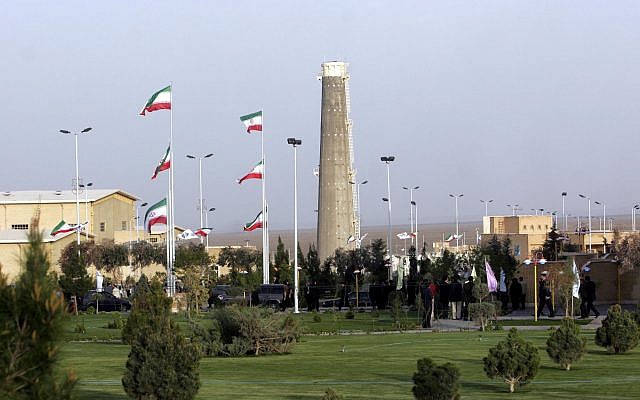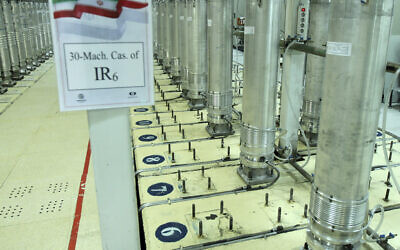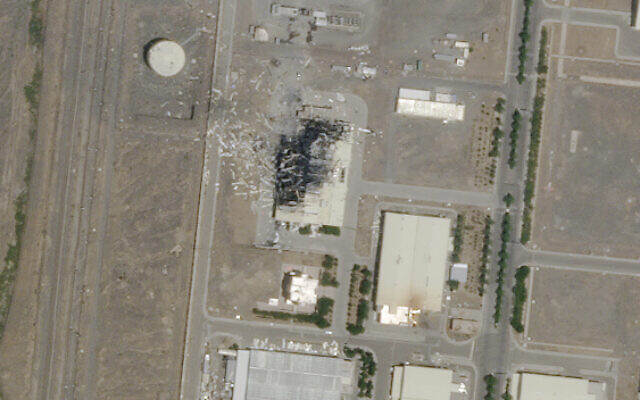Report says enrichment facility entirely stopped functioning since blast, nuclear program set back by at least 6 months; separate report says advanced centrifuges damaged

A blast at Iran’s Natanz nuclear enrichment facility that has been attributed to Israel was caused by a bomb planted at the site in advance, an Israeli television report said Monday.
According to Channel 13 news, the bomb went off Sunday at 4 a.m., when some 1,000 workers were at Natanz. The facility was reportedly evacuated immediately after the blast over fears of further bombs, but no other explosives were found.
The report, which did not cite a source, said the explosive was placed near the main electricity line at Natanz and that when it detonated, the entire facility stopped functioning. The facility remains non-functional, the report said, with the program set back by months.
“All the signs point to this being the worst attack that Iran’s nuclear program has suffered… at the most important Iranian nuclear facility,” said Alon Ben-David, the network’s military analyst.
Natanz has previously been targeted, including by an explosion that rocked the facility last summer, in what was also said to have been an Israeli attack aimed at disrupting uranium enrichment and research at the site. In 2010, the United States and Israel allegedly halted Iran’s nuclear program with the Stuxnet virus, which caused Iranian centrifuges to tear themselves apart, reportedly destroying a fifth of the country’s machines.
Israel is anticipating Iran will respond to the latest attack but not necessarily right away, according to Ben-David. He said such retaliation could come in the form of a cyberattack on civilian infrastructure, an attack on Israeli-owned ships, missile fire from Syria or Yemen, or cruise missile or drone attacks on strategic Israeli targets.

“Yesterday signifies that the faceoff between Israel and Iran has escalated to a higher level,” he said.
The network also said Iran may now try to expand its operation at the underground Fordo plant, where it has over 1,000 centrifuges. There were some 6,000 centrifuges at Natanz.
Separately, the Kan public broadcaster reported that advanced centrifuges were damaged in the blast at Natanz. The report, which cited an intelligence source, did not specify which model of centrifuges were targeted. Iran publicly inaugurated the advanced IR-5 and IR-6 centrifuges at the facility on Saturday.
The television reports came after the Iranians downplayed the extent of the attack, with a spokesman for the Atomic Energy Organization of Iran saying Monday that the blast was caused by a “small explosion” but insisting the damage could be quickly repaired.
Iran initially reported a power blackout had hit Natanz on Sunday, a day after it announced it had started up advanced uranium enrichment centrifuges banned under the 2015 deal limiting its nuclear program in exchange for sanctions relief.
Iran blamed Israel for the incident at Natanz, which according to The New York Times was caused by a massive blast at the centrifuges’ power supply. Israeli and US media quoted unnamed intelligence sources as saying it was believed to have caused significant damage to the centrifuges and set back Iran’s uranium enrichment ability by at least nine months.

The Islamic Republic has called the attack an act of “nuclear terrorism” and vowed “revenge on the Zionist regime.”
Sunday’s incident came as US Defense Secretary Lloyd Austin landed in Israel for talks with Prime Minister Benjamin Netanyahu and Defense Minister Benny Gantz. The US, Israel’s main security partner, is seeking to reenter the 2015 atomic accord aimed at limiting Tehran’s program so that it cannot pursue a nuclear weapon — a move staunchly opposed by Israel, particularly Netanyahu.
The US denied Monday that it was involved in the incident at Natanz.
As reported by The Times of Israel
